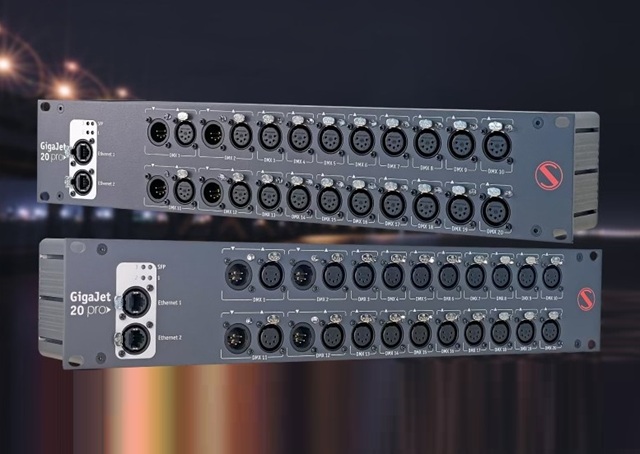
Modern musical productions require lighting that is not just bright but also precise and timely in responding to the movements of performers. One reliable way to achieve “smart” lighting is by using tracking via the RTTrPL protocol and the Sundrax GigaJet20 Pro DMX converter. Here’s how it works in practice:
1. How it works on stage
- The tracking system (for example, BlackTrax) tracks beacons on performers and transmits coordinates in the RTTrPL format.
- The GigaJet20 Pro receives the RTTrPL stream via Ethernet or through an SFP module and converts it into pure DMX512. The device has 20 fully isolated outputs, so each moving head receives its own line.
- The console (grandMA3, Hog 4, or Avolites) can directly “see” the RTTrPL universe via Art-Net/sACN or pick up the DMX signal from one of the converter’s outputs.
2. Why optical fiber
Optical fiber minimizes interference and can easily span hundreds of meters. In the GigaJet, the SFP slot transmits DMX data (up to 10 km), and the second channel is connected as a backup: if the main optical path is interrupted, the system instantly switches to the reserve, and the show continues without skipping frames.
3. Quick start with GigaJet20 Pro
- Open the built-in web panel.
- Set the IP address, enable PoE (if needed to power sensors or a small traffic light).
- On the “Universe Mapping” tab, assign the RTTrPL universe in Priority Mode — this is the priority channel for tracking that cannot be “overwritten” by other faders.
- Enable AUTO-merge or HTP-merge to smoothly blend the signal from the console and the tracker coordinates.
- Assign outputs 1–8 for moving heads, and outputs 9–20 can be left for other devices, such as smoke machines, strobes, or blinders.
4. Integration into the console
- Register a new universe for tracking in the console software.
- Create “palettes” for coordinates (Pan/Tilt) and intensity to enable the “follow-spot” mode with one click.
- By writing a simple macro, make the moving heads switch automatically when a performer appears in the tracking zone.
5. Live example
A guitarist steps onto the stage with a beacon on their belt. BlackTrax captures the position, GigaJet converts the data into DMX commands, and the spotlight literally “flies” after the musician (updates occur faster than every 25 ms). As a result, the light never lags — not even by a fraction of a second.
6. How to increase reliability
- Use branded SFP modules and high-quality optical fiber.
- Monitor the link-LED indicators on the converter and notifications in the web interface.
- For large concerts, link two GigaJets in a master-slave configuration: if one fails, the other will immediately take over the entire load.





